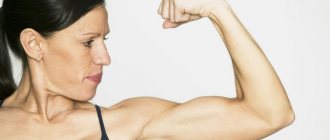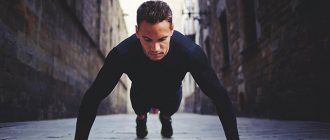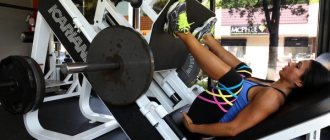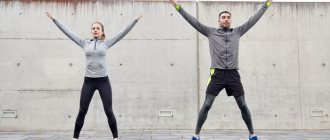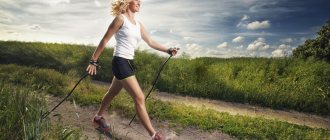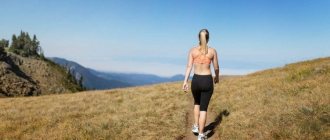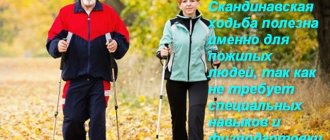Differences between race walking and running
Race walking differs from running in three key ways:
- technique;
- rules;
- speed.
These differences are especially clearly visible during athletics competitions, where you can see all the nuances of a particular discipline.
- In race walking, the athlete takes each step with a full foot, and one leg is always in contact with the surface, while in running, both legs are in the so-called “flight phase” between pushes.
- The walker's starting position is always upright, while runners may take a low starting position.
- According to the rules of race walking, the athlete must step on a straight leg, while in running - on a bent one.
| running speed | speed in race walking |
| from 16 km/h for long, up to 30 km/h for short | 8-10 km/h, professionals reach speeds of up to 16 km/h |
Compared to running, race walking is a less traumatic sport, since walking puts less stress on the leg than in running disciplines.
Execution technique
During race walking, a person's speed in km per hour is approximately 10 km/h, and professional athletes can accelerate to 16 km/h. Competitions are usually held in open areas, and if weather conditions do not permit, in an indoor stadium or arena. If you are wondering whether it is possible to practice race walking to lose weight at home, we will answer that it is advisable to still practice outside. You have to understand, you have to have enough space to accelerate, but if your square footage allows it, go for it. After all, this is a great alternative to running for weight loss.
So, now you know how race walking differs from regular walking, and now let’s look at the main points of the correct technique for performing it:
- When starting, the body is held straight, the gaze is directed forward;
- The arms are bent at the elbows at a right angle and held freely, without tension. During the movement, the hands help the athlete, moving in time with the steps, back and forth;
- It is important to follow the rule of touching the floor with one foot - if a separation of both legs is recorded, you will be removed from the competition;
- The leg on which you plan to take a step must be strictly straight until the foot touches the surface of the ground. Sharp knees during a step are a strict violation of technique.
These are all the basic requirements for technology. Let's continue our study of race walking with weight loss techniques for beginners, namely, how to lose weight using this discipline.
The benefits of race walking
Race walking is not necessarily a professional sport. Many people today use race walking as a recreational activity. The beneficial effects of race walking on the human body:
- normalization of the cardiovascular system;
- improving the functioning of the respiratory system;
- normalization of the gastrointestinal system;
- increasing stress resistance of the nervous system;
- reduction in subcutaneous fat levels;
- toning almost all muscle groups.
Benefits and harms
It is not at all necessary to engage in this sport professionally to achieve results. Many today practice discipline for health purposes, in order to tighten their figure, improve their health, and warm up. Let's look at the benefits of race walking, even if you do it unprofessionally:
- Normalizes the activity of the cardiovascular system;
- Trains breathing;
- Stabilizes the functioning of the digestive system;
- Relaxes, helps cope with depression;
- Promotes weight loss;
- Helps maintain muscle tone.
Race walking is unlikely to cause any harm, because it is considered one of the safest sports, however, if you have contraindications for health reasons, harm is possible.
In what cases is such physical activity prohibited? For blood pressure, exacerbation of chronic diseases, heart problems, diabetes, problems with the retina, ARVI, after a heart attack or stroke.
History of race walking
The first official race walking competition took place in London in 1882. It was continuous walking for 5 hours.
Race walking was first included in the Olympic program in 1932 (distance 50 km), and in 1956 race walking 20 km became an Olympic discipline. Since 1992, the program of the Olympic Games has included women's race walking competitions over a distance of 20 kilometers. The 10-kilometer distance was included in the program of two Olympic Games: 1992 and 1996.
Walking
Walking is the main method of movement for humans and most animals. A person masters walking on two legs in early childhood and uses this method of locomotion throughout his life. Various walking techniques allow you to consider walking as a sport, a fitness activity for maintaining health and improving well-being. Body characteristics, diseases and injuries can cause various pains when walking. MedAboutMe talks about what is considered proper walking, the benefits and harms of walking and its different types.
Race walking for weight loss
Race walking, like running, is an excellent tool for combating excess weight, but it is much less traumatic and has fewer contraindications.
- Start at a slow pace, the pulse should increase smoothly, gradually. Slow down also slowly and progressively;
- Do aerobic warm-up before walking and stretch after exercise;
- Pay special attention to your body position and movement technique in all phases;
- Drink water before and after exercise, and during exercise, wet your mouth with water if necessary;
- Choose the right shoes and clothes for race walking so that you don’t feel discomfort during training;
- Breathe correctly through your nose, continuing to monitor your pace;
- Do race walking in the morning on an empty stomach or in the evening 2 hours after dinner;
- Optimal training time: 40-60 minutes 3-5 times a week.
Is walking a means to lose weight?
This sport is an effective tool in the fight against extra pounds, and it is also one of the least traumatic. And also, it is allowed for very overweight people. The basics of technique and rules of race walking, if the goal is to lose weight, are the same as for people involved in this sport professionally, so study the previous section thoroughly.
Remember the following recommendations:
- Any workout always starts with a warm-up;
- Finish the session with stretching and breathing exercises (can be replaced with meditative walking);
- Start the lesson at a calm pace, gradually increase the speed;
- Maintain the correct body position and follow the technique;
- Drink water in slow sips during your workout. It is best to quench your thirst before and after class;
- Choose the right sports equipment and running shoes (lightweight, with a springy sole and a flexible toe, and for the cold season - a winter version);
- Inhale air through your nose and exhale through your mouth;
- Make sure that your last meal before training is at least 2 hours;
- Stick to the training program, don’t miss it, exercise well;
- The average training duration is 50-60 minutes, you should do 3-4 times a week.
Even if you have mastered and successfully practice different types of race walking, practice a lot and for a long time, but at the same time you do not eat properly, do not expect results. It is important to adhere to a low-calorie but balanced diet - in this case, the scale mark will definitely move to the left.
Monthly course for weight loss
In the first week, you should do three walking sessions at a slow pace. Each workout should not last more than 20 minutes. At this stage, it is important to understand how to breathe correctly and control the load.
In the second week, race walking begins. The speed varies depending on how you feel. The duration of one workout is up to 30 minutes. It’s not worth testing yourself for serious loads. If you feel tired, you can switch to a slower pace. In the third week, the duration of the lesson increases to 40 minutes. In addition, the number of workouts should already reach 4-5. At this stage, you can use special weight loss belts.
The final 7-day period should take place in an intensive mode. Training time varies up to an hour, but their number is still up to 5 sessions. It is important here to alternate the walking pace from maximum to average every 10 minutes. As numerous reviews show, in a month of training using this method you can lose up to 12 kilograms.
"Safety Tips" to Consider When Walking
- It is better to walk early in the morning so that the body has enough energy and blood circulation increases. Moreover, walking in the morning is also good for the body due to the absorption of vitamin D from the first rays of the sun.
- The faster you walk, the more calories you burn.
- Don't walk after eating. Some say that walking immediately after eating can improve digestion. However, this is a false concept as walking immediately after eating affects the digestive juices, thereby preventing the breakdown of food.
- It is not recommended to drink large amounts of water before walking, as this can disrupt the processes in the respiratory system.
- But it’s still worth drinking before training, as well as after it. Freshly squeezed juices will help revive metabolic processes, thereby helping the body burn more calories.
Have you ever thought about walking from a weight loss perspective? Always remember that as soon as you stop physical activity, all the results achieved disappear. So it’s time to put on some nice sneakers and step into a new and “slim” life.
Be healthy!
Race walking injuries[edit | edit code]
Source:
Muscle Stretching for All Sports
.
Author
: Kudryavtsev A.
Publishing house.
: Eksmo, 2012.
Race walking requires you to keep your body straight without leaning forward. The arms and upper body are used to establish balance and enhance the movement of the hips and calves. Most athletes clench their fists, but we would advise relaxing your palms - less stress on your back. Since you're almost running without lifting your feet or leaning forward, your "back" leg needs to stay longer while you walk around it. The ankle should be curved back to press down on the leg. The hips swing during the gait, which is the “signature” of race walking representatives.
Injuries occur due to excessive amplification and stride length. For example, because the “back” leg remains on the surface, the calf muscles become very tight, leading to ankle cracks. We also see Achilles tendon strains and pain behind the knees. Strong rotation of the body (wiggle of the hips) causes strains in the abdominal muscles, muscles in the ribs, lower back and glutes.
Race walking requires retraining the body so that it moves “in a new way.” At first everything will seem strange and you may experience discomfort. Flexibility is very important to perform certain movements: walking completely straight, keeping your feet flat, gaining and maintaining high speed, swaying your hips, and powering your lower body with your upper body.
Race walking is an interesting sport, but it does not put stress on all muscle groups. The range of motion here is extremely limited and you will need additional exercises.
One last piece of advice: be sure to invest in good sports shoes that provide good cushioning. Remember the need to replenish fluid losses. It is very important. Stretching should be done before walking, while walking (if you feel your muscles become stiff), and after walking.
Other types of cyclic sports:
- Cross-country skiing
- Cycling
- Hiking
- Running with obstacles
- Skates - running and figure skating
- Roller skating
- skiing
Walking on the steps
It is considered one of the most effective and progressive types of walking. Recommended only for well-trained athletes. Under no circumstances should this be performed by people who have problems with blood vessels and the heart.
Did you know that in 60 minutes of active walking up the stairs you can burn about 500 kcal? Be sure to alternate between ascending and descending. You can take a short rest while going down the stairs. Climbing is a test for strong-willed people. Do you live in a 17-story building? Yes, you have simply heavenly conditions for training!
Load calculation
If you approach walking exercises wisely, they will never harm your health. Each person is unique in himself, which means that for each there is an individual training program. In the first couples, you should not take as a basis the indicators of people who have been involved in sports for a long time, since they are already subject to heavy loads. As for the distance, a weekly race walk of 50 km is recommended for men, and about 40 km for women. However, only experienced runners can use these indicators as a guide. For beginners, it is better to start with 2-3 kilometers per day and increase the distance by 500 meters every week if health allows.
This sport has no age restrictions, but it all depends on the body. During your first workouts, it is recommended to regularly check your current heart rate, which should not exceed the threshold of 100 beats per minute. If at the beginning of the lesson there is discomfort in the muscles or joints, then you should immediately stop walking. In such cases, you should not stop abruptly; it is better to gradually slow down.
Recommendations
If you want to take up race walking for health purposes, then all you need is comfortable sneakers and a determined character.
In conclusion, some tips for beginners:
- Any good habit requires overcoming yourself, the first 3 weeks will be the hardest, then classes will become a necessity for you.
- Try to have fun, and not just walk a certain number of kilometers - listen to good music, choose interesting routes.
- Choose the optimal time - in this case there are no strict recommendations; for some, morning is suitable, for others evening.
- Set realistic goals for yourself. For example, walk to a certain place in a certain amount of time.
- Overcome your laziness!
Types of walking
Race walking is one of the types of walking. In addition, the following forms of this activity are distinguished:
- Nordic walking - its distinctive feature is the use of poles.
- Walking uphill or on hilly terrain.
- Walking for weight loss.
In addition, you can divide walking by speed:
- For walking – up to 4 km per hour, does not have any special health-improving effect.
- Accelerated or recreational - up to 7 km per hour, this is an intermediate stage between recreational and professional sports. Regular exercise helps achieve all the health goals of walking - lower blood pressure, lose excess weight, etc.
- Sports – up to 15 km per hour. It is intended for professional athletes.
Walking on hilly terrain
To denote this type of race walking, the following concepts are used: trekking, hiking and backpacking. They have nothing to do with sports, rather they are related to tourism and hiking in the mountains. The difference between these terms is the duration of the route and the equipment used.
If we talk about constant walks in the mountains, their usefulness lies in the fact that climbing a mountain is an excellent prevention of strokes and heart attacks. Proof of this fact is a small town in Switzerland (Blattendorf), access to which by road is limited due to the steep mountainous terrain around it, so its residents are forced to walk most of their lives. Despite these inconveniences, one interesting phenomenon is observed in this city - the population practically does not experience myocardial infarction, although the statistics for other cities in Switzerland are very deplorable.
It is not worth recommending that beginners start their hiking in mountainous areas, but it is obvious that they are more effective than walking on a flat surface. Mountain lovers point out one interesting feature - it’s easier to go up than to go down.
Walking on level ground
Walking on level terrain is typical for most people. The fact is that city residents rarely go to the mountains, and not all countries can boast of having them. In the city, it is very important to choose “natural” places for walks - parks, forests, walking areas, and avoid paths along polluted highways.
In the technique of sports recreational walking, it is important to observe the following point - when placing the foot on the ground (asphalt), the edge of the heel should not rest against the surface, as happens in running. Landing should occur on the middle part of the heel, then a soft roll to the toe should occur. In addition, if you have clubfoot or a tendency to turn your foot, then you need to eliminate this, otherwise long and constant exercise will only aggravate the problem and lead to joint injury.
Walking – concept, definition
Walking is a type of motor activity in humans and animals that provides active movement in space on a hard surface. In the process of human walking, complex coordinated activity of the limbs and skeletal muscles occurs. Depending on the walking technique, with this type of movement, up to 95% of the body’s muscles can be involved in the process.
Human walking: homo erectus
Human walking on two limbs differs from the method of locomotion of vertebrates. It is assumed that the first people to master upright walking were representatives of the species Homo erectus, Homo erectus, the direct ancestor of modern humans. This connection is evidenced by the structure of the femurs, identical to those of homo sapiens.
The transition to bipedia, walking on two legs, has long been considered a consequence of the labor concept of Friedrich Engels: “labor made a man out of a monkey,” that is, the forelimbs and arms began to be actively used for manipulating objects and babies, which led to walking exclusively on the hind legs limbs, legs.
However, modern researchers argue that the phenomenon of walking on two legs arose much earlier than the appearance of tools, for example, the remains of the first upright human ancestors date back to 7 million years, and objects used as tools date back only 2.7 million.
Hypotheses about the origin of upright walking include the need to cross water obstacles, often rise on the hind limbs when living on grass-covered spaces of the savannah, evolutionary “baldness”, the disappearance of hair from the body of mothers in warm climates, which forced the mother to use the forelimbs to hold the baby on the body . There are also theories based on the psychological advantage of erect walkers - the body looks larger, you can see further, as well as mathematical calculations that prove that walking on two legs is more energy efficient than walking on four limbs.
Most likely, the phenomenon of upright walking, a person walking on two legs, was formed under the influence of a whole complex of factors, and today we actively use this type of movement, without thinking about what large-scale changes in the body a person owes to the ability to freely use his arms and stand and move steadily on his feet.
The benefits of walking for the body
Walking will help remove extra centimeters, tone up, and tighten your thighs and calves. In addition, this type of weight loss brings the following benefits:
- has a positive effect on blood vessels;
- normalizes blood pressure;
- strengthens the heart muscle;
- reduces sugar.
Walking is an activity that even the most business person can do. But you need to train in moderation and according to certain rules. This type of training is especially suitable for beginners who are not used to serious physical activity.
We recommend that new kids start with 300-500 steps a day . At first glance, this is not very much, but unprepared boys and girls do not need to get ahead of the hell. Moderation and caution are the key rules for beginners.
The daily norm for a person is about 6 thousand steps per day. Unfortunately, recently people have begun to move less. Have computers and televisions enslaved the world? Partly yes, besides, today there are many professions that require sedentary work at a computer.
It is important to be able to prioritize correctly. Does work bring you pleasure? If yes, then great! Can't imagine life without sports? Now imagine how rich and cool the day will be when you combine two activities together!
General principles
Race walking is based on aerobic exercise, which helps effectively strengthen muscles and burn calories. One of the advantages of this sport is the minimal likelihood of joint injury, unlike running. The essence of walking is to move quickly, with one foot in full contact with the ground. Due to this, the steps are much longer and faster, and more muscles are also involved.
This sport is recommended for people who are slightly overweight. In fact, anyone can practice walking, as long as there are no serious health problems. This is why it is important to first consult a doctor for recommendations. On average, you can burn up to 300 calories in 2 kilometers walked at an average pace.
Walking: benefit or harm?
When considering such characteristics of walking as benefits and harms for the human body, it is worth remembering the structure of the human body. Adaptation of body structure to upright walking led to many changes during human evolution. These include:
- change in the base of the skull, movement of the foramen magnum;
- structure of the pelvic bones: upright walkers have a wider and lower pelvis than those who walk on all fours;
- structure of the long bones of the legs. Features and differences in the structure are clearly visible in dynamics, when apes move on two hind limbs, swaying to compensate for instability by oscillations of the body;
- foot structure: the presence of transverse and longitudinal insteps, shortened toes, lack of opposition and abduction of the big toe;
- the structure of the hands of modern man is also a consequence of the transition to upright walking. Our hands are not adapted for moving on the ground, but they are adapted for using tools;
- The erectus spine has special curves and is located along the vertical axis.
These changes in the body led not only to the ability to more economically spend energy when moving, to see the environment better, to free up hands for carrying and working with tools, but also influenced the stability of the entire musculoskeletal structure and led to the emergence of diseases unfamiliar to animals moving on land. four limbs.
Increased load on the spinal column and lower limbs, especially in combination with low physical activity and constant wearing of shoes, companions of modern man, can lead to pain when walking, as well as complications in the presence of certain diseases. However, walking, the benefits and harms of which have been studied and proven in various aspects, is, as a rule, not the direct cause of diseases.
The benefits of walking and hiking
The benefits of walking are undeniable. In addition to the obvious factors: movement, being in the fresh air, hardening, relieving psycho-emotional stress during simple walks, experts say that walking directly affects the health of the body and a person’s well-being. Thus, the following facts testify to the benefits of walking and hiking:
- regular walking for 30 minutes a day can reduce the likelihood of developing tumors in the intestines by 30%;
- at least half an hour of walking daily at an accelerated pace has a beneficial effect on the cardiovascular system, reducing blood pressure by filling the vessels of the arms and legs;
- active contraction of the lower leg muscles when walking helps maintain the tone of the blood vessels in the legs and reduces the likelihood of varicose veins of the lower extremities. Half an hour of walking a day is enough to prevent this disease;
- a decrease in the level of adrenaline and cortisol and an increase in the amount of endorphins in the blood accompany any physical activity, including walking. Thus, even a short walk can have a beneficial effect on mood at a physiological level;
- Physical activity is necessary for the body to absorb calcium. The benefits of walking for strengthening the bone skeleton and the entire musculoskeletal system are undeniable: calcium is absorbed better, and ligaments are strengthened with constant load on them;
- Finally, walking, although not the most energy-intensive activity, nevertheless increases the body's calorie expenditure. 200-300 kilocalories consumed during an hour of walking at different paces help maintain overall shape and even lose weight for those who want it.
Walking therapy
Healthy walking is a treatment area that is almost 200 years old. It is reliably known that at the beginning of the 19th century, European doctors prescribed regular walks along the sea, along the hills and mountain resorts for patients with certain diseases.
Walking therapy is the use of a natural form of physical activity for humans. The advantages of walking therapy in the absence of any conventions: classes can be started in any area, at any time of the year, there is no need to purchase additional exercise equipment or equipment, just a pair of comfortable shoes.
Walking is the best choice for those who are overweight, weak, or have not previously exercised. The ability to independently control the load, speed, distance, combine walking therapy with a walk in nature, shopping or going to work allows you to actively use this method of therapy and prevention for any type of employment.
If the body is unprepared or recovering from an illness, it is recommended to start classes with a preparatory type of health walking, performed at a slow pace (60-80 steps per minute) or at the usual speed. In this case, it is necessary to control the frequency of breathing and pulse.
Gradually increasing the intensity of movement, after a while you can switch to the main type of therapeutic walking. It alternates between fast (100 or more steps per minute) and slow walking; the speed at the beginning of the movement should be comfortable enough so that breathing does not become difficult. After 5-10 minutes of a slow pace, they switch to fast walking for 3-5 minutes, then return to slow.
The duration of the entire lesson is 30-40 minutes. Before starting, you need to do a short (10-15 minutes) physical warm-up; in conclusion, there is always a stage of slow walking and breathing exercises, relaxation, and muscle stretching.
Experts advise not to pace yourself, especially for patients recovering from illness or having difficulty with physical activity.
health path
Health path as a type of therapeutic walking and sports activity has been known since 1885. Therapy with regular walks over rough terrain with specially selected parameters for changing the slope of the surface, distance and pace was introduced into use by the German doctor Ertel.
In Russia, health paths became known at the end of the 19th century thanks to N.N. Obolonsky, who spread a new method of walking treatment and prepared one of the very first routes for this type of treatment in the park of Kislovodsk.
Initially, health paths as a method of walking treatment were prescribed to patients with excess weight, diseases of the cardiovascular and respiratory systems. However, it soon became clear that it had a beneficial effect on the musculoskeletal system, improved metabolic processes, and overall health of the body.
Terrenkur as a technique is divided into three types:
- easy: distances up to 500 meters, terrain with virtually no slope or changes in altitude;
- medium: distance 1.5 km, there are relief changes in the terrain along the route, changes in pace and walking time are added;
- difficult: distances from 3 to 8 km, the route passes through hills from 600 to 6,000 m above sea level, many sections with variable walking speed are included.
Before starting the route, it is advisable to do a short physical warm-up. You should go for a distance in the morning or choose weather that is not accompanied by heat and high solar activity.
While walking, you can make stops if necessary, accompanying them with breathing exercises and muscle stretching. It is recommended to take water with you for drinking, but the total weight of things on the route should not exceed 2 kg.
If there are indications or pain in the back, the routes can be overcome in a bandage or corset; as the musculoskeletal system strengthens, the need for such support, as a rule, disappears.
A sign of a correctly chosen route and completed it at a suitable pace is a feeling of slight muscle fatigue upon completion.
Walking for weight loss
Walking is a good sport for those who want to lose weight but are unable to move actively. Excess weight often leads to diseases of the musculoskeletal system, critical load on the joints of the legs, and concomitant diseases. With such a clinical picture, running and strength sports are not recommended, and various cardio exercises and fitness can become a significant test for an unprepared body.
At the beginning of sports therapy, overweight people are recommended to swim and walk - to lose weight and gradually train the body before starting additional loads. The advantage of walking for weight loss is that for such activities you do not need to select a pool or pond, depend on the vagaries of the weather, or select additional equipment. Even walking indoors, in one place, has a positive effect on the body, which allows you to create a gentle regime and gradually increase the body's endurance.
Walking in place is performed without moving horizontally, with raising the hips and knees. You should start with 5-10 minutes, gradually increasing the duration of classes to 1-1.5 hours. The walking pace is from 50 to 60 steps per minute, and a step is considered to be the movement of only one leg, for example, the right one.
For a full-fledged exercise in walking for weight loss, it is recommended to maintain pace and speed, focusing on the heart rate: it should not exceed 70% of the maximum heart rate (220 - age in years). An accelerated heartbeat, but not exceeding this value, provides sufficient load to burn fat reserves. A pulse above the permissible 70% of the maximum means that the body begins to use carbohydrates rather than fats as an energy source.
Walking for weight loss includes walking at intermittent speeds, carrying weights, as well as climbing on inclined surfaces of a natural landscape or a treadmill, which provide additional stress on the muscles.
Walking: calories burned by different types of walking
An activity such as walking burns calories at a moderate pace. The energy consumption of the body during walking largely depends on the following factors:
- age;
- body weight;
- gender;
- age;
- features of the body's metabolism;
- walking pace;
- duration of walking time, route distance
- level of physical fitness and the ratio of muscle and fat tissue in the body;
- the presence of sections of increased complexity on the route: ascents, descents, obstacles;
- use of additional equipment: Nordic walking poles, weights for arms, legs, back;
- additional exercises and walking techniques.
With this type of physical activity, such as recreational walking, calories are calculated depending on body weight and speed of movement. So, with an average walking pace of about 4 km/h. a person spends 3.2 kcal for every kilogram of weight. At a speed increased to 6 km/h - 4.5 kcal/kg, at a high speed (8 km/h) - 10 kilocalories per kg.
Less accurate, but convenient for those people who do not have the ability to determine the distance traveled, the method of calculating energy consumption is based on the number of steps per minute: 50 steps approximately correspond to a speed of 3 km/h, 66 - 4 km/h, 83 - 5 km /h., 100 steps – 6 km/h.
To calculate energy consumption when moving, auxiliary means are also used to accurately determine calorie consumption when walking. The most common are fitness bracelets, trackers and software in mobile communications. Depending on the level of measurement accuracy for which the device is programmed, it is required to enter body weight, gender, age, walking speed and calories burned during movement are calculated based on the entered indicators and data on the location of the device.
If it is necessary to increase the load and/or energy consumption while walking, it is recommended to use the following techniques:
- load in the aerobic zone, with a rapid heart rate, but not more than 70-80% of the maximum allowable;
- tension in the abdominal muscles and buttocks while walking;
- tracking the correct posture: straight back, gaze directed forward (chin horizontal to the surface);
- routes over rough terrain, with ascents and descents;
- routes on loose or low-density surfaces: sand, gravel, snow, soil, etc.;
- additional activity during movement: swinging with arms bent at the elbows, raising the knees up, extended steps, walking “sideways”, side steps, backwards, walking up stairs, etc.;
- use of additional equipment: Nordic walking poles, weights;
- interval training method, alternating high and medium walking pace.
Fast walking: energy consumption of the body
The higher the pace, the greater the calorie consumption; this rule works for all types of physical activity. Fast walking starts at a speed of 6 km/h; for professional athletes, the speed reaches 15 km/h with a special movement technique.
As speed increases, the body's energy consumption increases significantly. So, a person with a body weight of 70 kg walks for 1 hour at a speed of 3 km/h. On average, it consumes 175 kcal at a speed of 6 km/h. – 303 kcal, 9 km/h. – 674 kilocalories. And this effect is achieved by moving on a flat surface without additional loads, weights, or equipment. Brisk walking with poles or Nordic walking technique increases calorie expenditure by 46%,
Determining the optimal walking time to calculate energy costs
Knowing your body parameters, you can calculate the approximate walking time required to burn a certain number of calories. So, if a person with a body weight of 70 kg wants to take a walk for health purposes and spend 200 kcal, then at a speed of 3 kilometers per hour he will need almost 60 minutes, when moving at a speed of 5 km/h. – 38 minutes, 6 km/h – 29 minutes.
If the Scandinavian movement technique is used when walking, the time required to burn 200 kcal will decrease by 33% and, depending on the pace of walking, will be 40, 25 and 15 minutes, respectively.
Any complication of the route, the use of weights and additional physical activity while walking increase the energy consumption of the body.
Harm from walking
You can often hear about the dangers of walking from people who are forced to spend a long time “on their feet” or in motion. However, walking, the harm of which is attributed to the occurrence of various diseases, is actually not the root cause. Diseases of the musculoskeletal system, vascular system, type 2 diabetes, inflammatory processes in the tendons, etc. are not consequences of walking, but the manifestations of such diseases can intensify with physical activity while moving.
Walking for a long time in uncomfortable, incorrectly selected shoes can harm the musculoskeletal system, primarily affecting the foot. If the foot muscles are poorly developed, walking in this type of shoe can affect the progression of flat feet, causing pain and provoking the development of associated deformities and diseases.
Experts say: walking at a pace and load that matches the capabilities of a particular person is beneficial to the body. The only possible option in which walking can still cause harm is when trying to move on a slippery surface, for example, during icy conditions. Injuries caused by falls in such cases can be correlated to some extent with walking.
Race walking[edit | edit code]
Source:
Sports Encyclopedia of Life Support Systems. Editor
: Zhukov A.D.
Ed.
: Unesco, 2011.
Race walking
characterized by the presence of mandatory constant support on the ground with one or both legs at the same time. Accordingly, in the step cycle of walking, one- and two-support positions are distinguished. The single-support position is decisive. In the so-called cycle “double step”, it is customary to distinguish the phases of “backward” and “front” steps. Their combination represents the movement of the free leg forward, performed by flexing the hip. This is the so-called swing step, which not only prepares the free leg for the next push-off, but also takes on the role of a movement that dynamically serves the push-off performed by the supporting leg. The dynamically determining component of the stepping movement is the actions of the supporting leg when it moves backward on the support, performed with hip extension, i.e. - support step. The two-support position in race walking is extremely short-lived (0.02-0.03 s) and does not play a significant role in walking technique. Coordination of movements during any walking is of a complex cross nature, inherent in phylogenesis and developed in ontogenesis. It covers simultaneous interrelated actions of almost the entire motor system, including the pelvic, shoulder girdle and arms. Swinging work with the shoulder girdle and arms with rotation of the masses of these links (primarily around the vertical axis) plays an important energetic role. Without sufficiently powerful work of the upper sections of the entire kinematic chain, energetic walking is in principle impossible. The movement of the general center of gravity of the walker’s body sums up the movement of all the masses of the athlete’s body. In general, it tends to a straight horizontal trajectory, but usually makes oscillatory movements in all three main planes of movement, mainly in the sagittal.
- Race walking.
- Race walking. Single support phase. Rear support
- Race walking. Double-support phase
- Race walking. Single support phase. Front support
- Race walking. Foot placement
- Race walking. Hip movement
- Race walking. Hand movement
Main article:
Race walking technique
Shoe selection
The most important piece of equipment for a walker, as for a runner, is shoes. The basic requirements for sports shoes are as follows: they must be convenient, comfortable, and the right size. Shoes, ballet flats, slippers and other semi-athletic footwear should not be used for regular training. It is better to take sneakers designed for running on rough terrain.
They have the following properties:
- They have good grip on the surface due to the tread.
- Provide good shock absorption.
- Sneakers with a membrane do not allow moisture to pass through and are warmer, while without a membrane they provide good air circulation.
- They are light in weight.
- The heel and foot are fixed quite rigidly - the leg will not dangle freely during training.
How to warm up properly
First, you need to start by stretching your calf muscles. To do this, you need to rest your hands on the wall, move one leg back, and raise and lower your body with the other (supporting leg). The exercise should consist of 8-10 approaches and last up to 7 minutes.
To warm up the back of your thigh, stretch your leg forward and place it on a stool. Next, you need to slightly tilt the body towards it. The front area of the thigh is warmed up with the following exercise: one leg is the supporting leg, and they try to bring the foot of the second as close as possible to the buttocks with their hand.
The hips are warmed up by alternately lunging the body forward and backward with the foot placed on a stool. For this control it is important to relax extremely.
According to athletes, warm-up should last at least 20 minutes. During this time, all muscles should not only be stretched, but also warmed up well in order to protect yourself from unnecessary injury.

